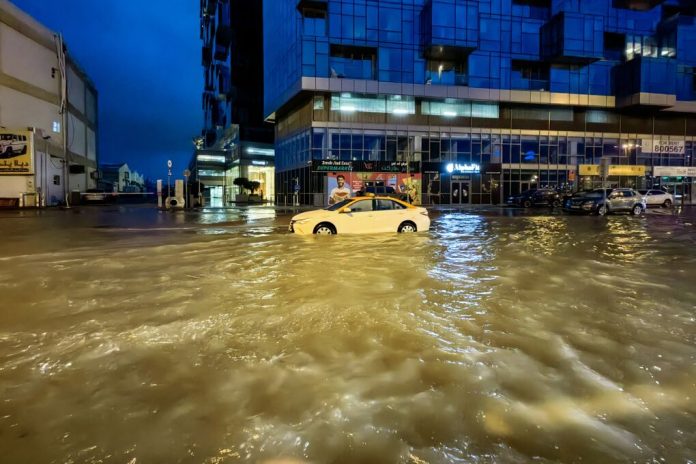Dubai, known as the financial hub of the Middle East, has been severely impacted by heavy rain and storms, resulting in widespread flooding across the desert nation. The unprecedented rainfall has caused flight delays and diversions, with vehicles stranded on waterlogged roads.
The catastrophic floods in Dubai have followed the heaviest recorded rainfall, reaching approximately 25 cm (10 inches), almost equivalent to the UAE’s typical two-year rainfall.
The heavy rainfall has been attributed to a larger storm system moving across the Arabian Peninsula and advancing over the Gulf of Oman. Scientists suggest that changing climatic conditions and global warming may have exacerbated the intensity of the rain in Dubai and Oman. However, there are at least three factors that may have led the heaviest rain to culminate into worst man-made disaster of Dubai.
Scarce tree cover
Despite its arid climate and limited rainfall, the UAE’s desert landscape, coupled with sparse tree cover, makes it vulnerable to floods as well. The forest cover in UAE is merely 4 per cent of the total land. Trees play a crucial role in absorbing water through their roots, reducing the force and volume of runoff. However, the absence of trees diminishes the soil’s water-absorbing capacity, leading to significant runoff and soil erosion. This erosion further contributes to raised riverbeds or seabeds, increasing the risk of floods.
Although, the initiatives of afforestation were taken but the urge of making UAE a modern dream place with advanced facilities outpaced the desire for sustainable UAE. In 2010, Sheikh Mohammed bin Rashid al-Maktoum, the vice president and PM of the United Arab Emirates and ruler of Dubai announced 1 million tree initiative but that initiative never conceived its goal as, the place of nursery – where the plants would be grown before moving them across Emirates – was decided to be used for building Mall of the World, world’s biggest shopping centre. Later in 2016, plans were improvised to build Jumeirah Central. Hyper-development overpowered the environmental concerns, which were obviously not taken seriously back then.
Drainage system
Dubai’s drainage system has been a longstanding concern. In the 2000s, the city lacked a proper underground drainage system, relying on trucks to evacuate sewage waste from buildings, which often dumped them behind huge sand dunes or grounds outside the city. With time, administration realised the necessity and imminent harm to its prestige and things started to change. As of 2013, 70% of sewage waste was drained through the drainage system while rest 30% was still dependent on sewage truck. Majority of the latter, are the areas of Old Dubai. Though, Dubai has affirmed to get fully functional and proper drainage system by 2025, with a $21.8 billion sewage system plan approved in June 2023, the problem of inadequate drainage system still persists and may have augmented the detrimental consequences of the rainfall and flood.
Cloud seeding
Cloud seeding is another factor widely discussed in relation to Dubai’s weather management. The UAE has been experimenting with cloud seeding since 1982 as a means to enhance precipitation. This technique involves dispersing substances into clouds to stimulate rainfall. Different methods, such as dispersing salts or directing infrared into clouds, can encourage rainfall. While cloud seeding can provide relief to drought-affected areas and support various sectors, it also poses challenges and potential side effects. These include environmental harm, disruption of natural climatic patterns, and uncertainties regarding the effectiveness and duration of rainfall. Despite these challenges, cloud seeding remains a part of Dubai’s adaptive approach to weather management.
Some argue that, the cloud seeding may have impacted the natural cycle of climate with the latest floods as its ill effects.

